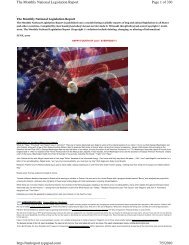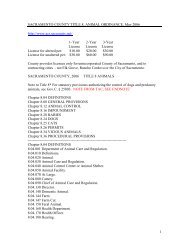San Diego County Survey and analysis of the pet population Karen ...
San Diego County Survey and analysis of the pet population Karen ...
San Diego County Survey and analysis of the pet population Karen ...
You also want an ePaper? Increase the reach of your titles
YUMPU automatically turns print PDFs into web optimized ePapers that Google loves.
SUMMARYThe following survey was performed in <strong>San</strong> <strong>Diego</strong> <strong>County</strong>, California to evaluate <strong>the</strong> dog<strong>and</strong> cat <strong>population</strong> for possible management considerations. The survey was a scientific,demographic, <strong>and</strong> comprehensive study on owned <strong>and</strong> unowned dogs <strong>and</strong> cats in <strong>the</strong>county. The results were particularly examined as how to reduce <strong>the</strong> number <strong>of</strong> animalseuthanized in <strong>the</strong> shelters. Specific groups were identified as particularly well-suited toprograms shown effective elsewhere in reducing euthanasias. Unowned, roaming catscomprise over a third <strong>of</strong> all <strong>the</strong> known cat <strong>population</strong>, <strong>and</strong> are <strong>the</strong> greatest numberseuthanized. Owned <strong>pet</strong>s are likely to be spayed or neutered, <strong>and</strong> unlikely to be h<strong>and</strong>ledby Animal Control or humane shelters. Purebred animals are not a problem <strong>population</strong>.Several solutions to fit <strong>the</strong> particular needs <strong>of</strong> <strong>San</strong> <strong>Diego</strong> <strong>County</strong> are cited, including:trap, alter <strong>and</strong> release programs, spay/neuter vouchers, renter-l<strong>and</strong>lord incentives <strong>and</strong>continued educational programs.INTRODUCTIONIn <strong>the</strong> past few years, national concern has grown regarding <strong>the</strong> number <strong>of</strong> animals euthanized in shelters.Because <strong>of</strong> this interest, many communities—including <strong>San</strong> <strong>Diego</strong> <strong>County</strong>—are considering variousactions to manage <strong>the</strong>ir dog <strong>and</strong> cat <strong>population</strong>s. Well-directed, enforceable proposals require a firmknowledge <strong>of</strong> <strong>the</strong> community <strong>and</strong> specifics <strong>of</strong> its <strong>population</strong>—both human <strong>and</strong> animal. Lack <strong>of</strong> suchinformation, however, has been a stumbling block with many proposed solutions. Data, when available, is<strong>of</strong>ten incomplete <strong>and</strong> inconclusive.Hastily enacted proposals, driven by emotions, can cause harm to <strong>the</strong> very animals <strong>the</strong>y seek to protect.Emotions flare over animal issues. Media sensationalize images <strong>of</strong> animals behind bars or dead fromeuthanasia to fan <strong>the</strong>se emotional fires. Thoughtful topics regarding <strong>pet</strong> ownership rarely make <strong>the</strong> news.The lack <strong>of</strong> reliable information stems mainly from many humane societies across <strong>the</strong> country not keepingdetailed records. There are no central clearing houses for data collection. Numbers conflict even to <strong>the</strong>country’s number <strong>of</strong> shelters, <strong>and</strong> what data <strong>the</strong>re is regarding <strong>the</strong> number <strong>of</strong> animals being h<strong>and</strong>led variesby several million.In order to truly solve a problem, it must first be carefully defined. To solve an animal control problem,<strong>the</strong>re must be adequate knowledge <strong>of</strong> what kind <strong>of</strong> animals are being discussed, where <strong>the</strong>y are comingfrom <strong>and</strong> in what kind <strong>of</strong> numbers. Without this information no effective solution can be presented.National Pet Alliance (NPA), a <strong>San</strong> Jose based, nonpr<strong>of</strong>it organization was hired to conduct acomprehensive survey on <strong>the</strong> nature <strong>of</strong> <strong>pet</strong> ownership in <strong>San</strong> <strong>Diego</strong> <strong>County</strong> (SDC). <strong>Karen</strong> Johnson <strong>and</strong>Laura Lewellen recently completed a similar survey <strong>and</strong> <strong>analysis</strong> on <strong>pet</strong> ownership for <strong>San</strong>ta Clara <strong>County</strong>on behalf <strong>of</strong> NPA. 1This study was conducted to examine several important <strong>and</strong> diverse questions concerning animals in SDC,both owned <strong>and</strong> unowned.The following report is based on a telephone survey <strong>of</strong> a cross-section <strong>of</strong> <strong>San</strong> <strong>Diego</strong> <strong>County</strong>. Theindependent firm, Nichols Research <strong>of</strong> Sunnyvale, CA conducted <strong>the</strong> phone survey. Johnson <strong>and</strong> Lewellenperformed <strong>the</strong> statistical <strong>analysis</strong>. The methodology is given at <strong>the</strong> end <strong>of</strong> this report, along with a sample<strong>of</strong> <strong>the</strong> survey form <strong>and</strong> <strong>the</strong> results for each question.




